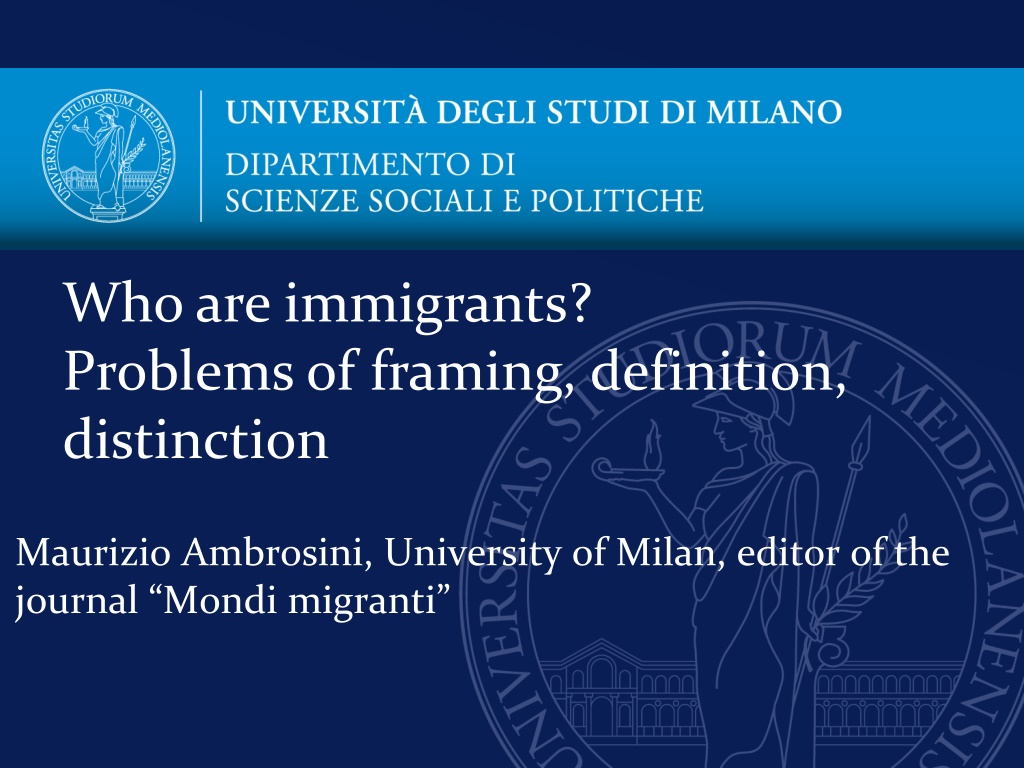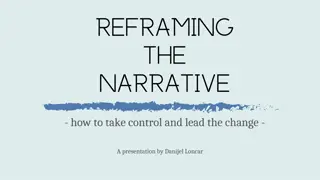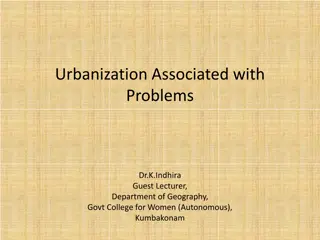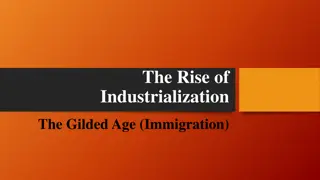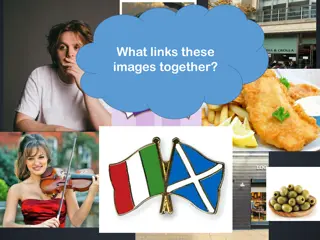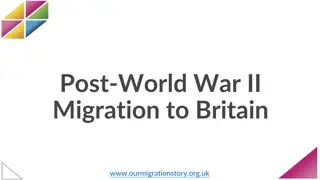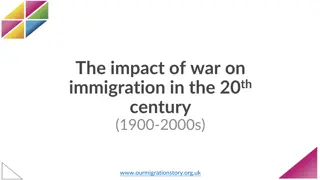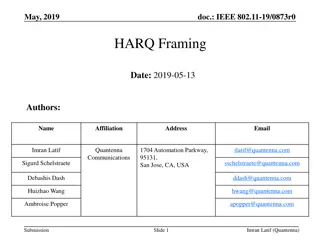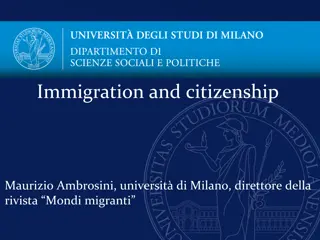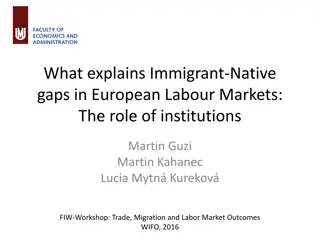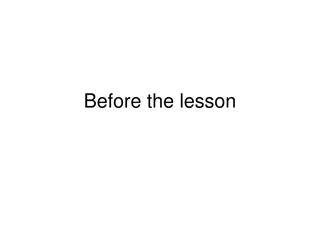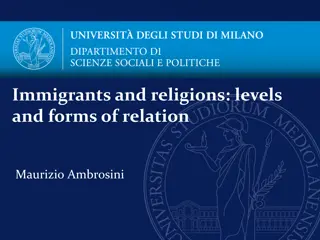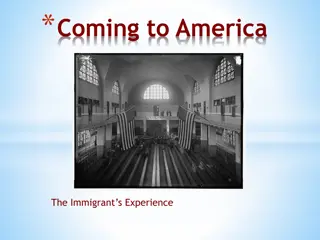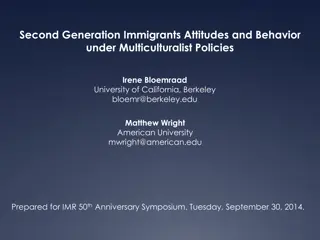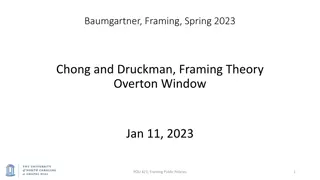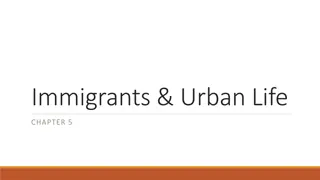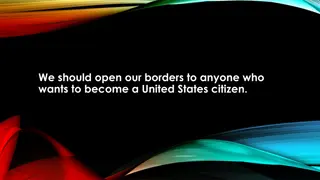Understanding Immigrants: Perspectives on Framing and Definition
Immigrants are individuals who have moved to a foreign country and resided there for over a year. Maurizio Ambrosini sheds light on the challenges in defining and categorizing immigrants, highlighting issues such as seasonal immigrant workers and second generations. The perception of immigrants as "others" and the stigma attached to their differences contribute to difficulties in acceptance and integration. Mobility regimes vary, with skilled workers enjoying more freedom of movement compared to manual workers and refugees. A dynamic vision reveals improvements in legal status and social representation for certain migrant groups over time, influenced by economic development and social acceptance.
Download Presentation

Please find below an Image/Link to download the presentation.
The content on the website is provided AS IS for your information and personal use only. It may not be sold, licensed, or shared on other websites without obtaining consent from the author. Download presentation by click this link. If you encounter any issues during the download, it is possible that the publisher has removed the file from their server.
E N D
Presentation Transcript
Who are immigrants? Problems of framing, definition, distinction Maurizio Ambrosini, University of Milan, editor of the journal Mondi migranti
Definition An immigrant is a person who moved to a foreign country, and who has been there for more than one year (UN) Threeelements: Moving Crossing a national border Fora prolonged period of time (1 yearor more) Problems: Seasonal immigrantworkers Second generations
The double Otherness of migrants We do not define a person coming from US, Switzerland or Japan immigrant , even though he/she is included in the definition quoted above We do not name a businessperson, or a sport champion immigrant , even though he/she comes from a country of the Global South Immigrants are people framed as poor and strangers
Superdiversity? The difficulty in the acceptance of people perceived as the Others is linked with the perception of a deep break of the social order and of the homogeneity of the Nation we are obliged to live with people who are different because of their language, citizenship, religion, cultural habits Our social landscape is perceived as radically altered These differences are combined with a social stigma: these people are seen as inferior The term immigrant comes to imply a pejorative meaning
Mobility regimes The mobility turn (Urry) is valid only for skilled workers and professionals They can move quite freely an bring with them their families There is a social stratification of mobility in the world Manual workers from the Global South, their families and refugees are targeted as immigrants to exclude or to integrate.
A dynamic vision Italian, Spanish, Greek migrants in Northern Europe have improved their legal status and social representation over time Citizens of EU new member countries are doing the same The economic development has similar effects in legal treatment and social acceptance
Immigration in Italy (and Europe): common vision and actual data Common vision Strong increase of immigration in numbers Asylum is the main reason Migrants are mainly men Migrants come mainly from middle East and Africa Migrants are mainly muslim Actual data Immigration is stable (about 5,5 million +0.6 million of irregular immigrants) Work and family are the main reasons (0,30 million of refugees/ asylum seekers) Migrants are mainly women Migrants are mainly European Migrants come mainly from traditionally Christian countries
Different types of migrants Economic migrants Seasonal migrants (now: circular migrants , in a triple win scenario) Skilled migrants and investors (we can include also students) Migrants for family reasons (or secondary migrations ) Second generations (are they immigrants?) Asylum seekers and refugees Irregular migrants, clandestines, victims of traffick Return migrants Retired people residing abroad
The historical periods of international migrations in contemporary history 1830-1914: transatlantic migrations from Europe 1914-1945: refugees and first regulations 1945-1955: new refugees and reconstruction after the war 1955-1974: migrations towards Northern Europe and economic development 1974-now: restriction, selection, free circulation in the EU, irregular migrations
Six trends in contemporary migrations (Castles, de Haas and Miller) Globalization of migration Changing direction of migration flows Differentiation Proliferation of migration transitions Feminization of labour migration Growing politicization of migration
Phases or stages of migrations 1) First arrivals: young workers, without families, with the proposal to stay temporarily 2) New arrivals, workers even now. People with less resources, but sponsored by the hubs . Time extends 3) Family reunions: spouses and children arrive, Immigrants settle 4) Formation of ethnic minorities. Political and cultural demands. Creation of ethnic institutions
